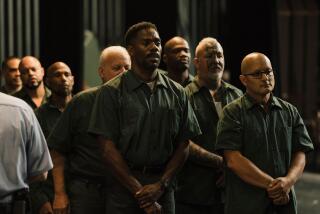Revisiting home as newly hallowed ground
Drawing loosely upon his own coming-of-age in Astoria, Queens, Dito Montiel with “A Guide to Recognizing Your Saints” traverses familiar territory with a fresh and intense perspective that wrests new meanings from the New York ethnic working-class neighborhood experience.
Dito (Robert Downey Jr.), a successful writer living in Los Angeles, receives word from his mother, Florie (Dianne Wiest), via a childhood friend that he must come home to get his ailing but stubborn father, Monty (Chazz Palminteri), into a hospital. Dito has not been in Astoria for some 15 years and has apparently been out of touch with his parents all that time. A flood of memories takes him back to the fateful summer of 1986 when he was a high school student.
Astoria has changed far less than other sections of New York, and the view of its rooftops from an elevated train is enticingly lyrical -- a community of solid early 20th and late 19th century buildings constructed on a human scale and offering a sense of enduring security and stability. First-time feature director Montiel, son of a Nicaraguan father and an Irish mother, evokes a deep sense of community but ever so casually introduces an element of danger that threatens to undermine it, through increasing tensions between long-entrenched residents, largely Greek and Italian, and more recent arrivals, Puerto Rican and African American. Montiel, who also wrote the screenplay, approaches this dicey situation with a highly effective indirectness typical of the entire film.
The “saints” of the film are Dito’s friends, and on first impression they aren’t very saintly or even very interesting. It’s clear that the teenage Dito (Shia LaBeouf) is bright and probably talented, as is his new friend Mike O’Shea (Martin Compston), an Irish kid recently arrived from Scotland. They hang out with, among others, Antonio (Channing Tatum), a big muscular guy with an abusive father, a kid who seems headed for trouble. Dito has a girlfriend, Laurie (Melonie Diaz, of the ingratiating “Raising Victor Vargas”) who seems more serious about him than he is about her.
It is Montiel’s special knack to make these young people, including his alter ego plus his parents, seem archetypal and therefore surprisingly powerful in their impact. Montiel doesn’t ask the viewer to care for them as a conventional writer-director would but reveals the adult Dito discovering how important they all were to him because of their unshakable allegiance. Primarily these teens hang out, and the film spends lots of time in Dito’s kitchen, where his loving father dispenses nonstop conventional wisdom as a devoted wife looks on. Yet for the young Dito his neighborhood isn’t just getting rougher but also more stifling, as he and his pal Mike plot their escape to California.
The central irony of the film is that adult Dito discovers how much he cares for those who by and large haven’t much going for them, and in the instance of Dito’s father, can even seem tiresome.
There’s a quality of daring in Montiel’s approach, trusting that the intensity of his feeling for his characters can become contagious, and in the distinctive way he backs into his story and its scenes, moving from jagged, intimate moments to large-scale images that imbue the film with a sense of the beauty and magic of memories.
The actors, who include Rosario Dawson as the adult Laurie, are all clearly caught up in their writer-director’s vision -- they couldn’t be more committed than if they were acting in Eugene O’Neill’s “The Iceman Cometh.” It’s understandable that earlier this year at Sundance, Montiel would take the dramatic directing award and his cast a special jury prize for best ensemble performance. In “A Guide,” passion and imagination go a long way in transforming seemingly conventional material and characters.
*
‘A Guide to Recognizing Your Saints’
MPAA rating: R for pervasive language, some violence, sexuality and drug use
A First Look Pictures release. Writer-director Dito Montiel. Inspired by a portion of Montiel’s memoir, “A Guide to Recognizing Your Saints.” Producers Trudie Styler, Travis Swords, Charlie Corwin, Clara Markowicz. Executive producers Sting, Bobby Sager, Peter Sahagen, Amanda Mackey. Cinematographer Eric Gautier. Editors Christopher Tellefsen, Jake Pushinsky. Music Jonathan Elias. Costumes Sandra Hernandez. Production designer Jody Asnes. Running time: 1 hour, 38 minutes.
At selected theaters.
More to Read
Only good movies
Get the Indie Focus newsletter, Mark Olsen's weekly guide to the world of cinema.
You may occasionally receive promotional content from the Los Angeles Times.










